Sushi is a Japanese dish that has gained popularity worldwide. It is a unique dish that comprises of vinegared rice and various toppings, including seafood and vegetables. Sushi is known for its distinct taste, which is a combination of different flavors that merge together to create a harmonious taste.
Understanding the flavor profile of sushi can be challenging, especially for those who have never tasted it before. The taste of sushi varies depending on the ingredients used, the type of sushi, and the chef’s preparation style. In general, sushi has a neutral, tangy, and sweet taste, with a fishy flavor due to the raw seafood used as toppings. The texture of sushi is also an essential factor that contributes to its unique taste.
If you are a sushi newbie, you might be wondering what sushi tastes like. In this article, we will explore the taste of sushi, the ingredients used, the different types of sushi, and their taste. We will also delve into the texture of sushi, how to eat sushi, the health benefits of sushi, and the role of the sushi chef. By the end of this article, you will have a better understanding of what sushi tastes like and why it is a beloved Japanese dish.
Key Takeaways
- Sushi has a distinct taste that is a combination of different flavors that merge together to create a harmonious taste.
- The taste of sushi varies depending on the ingredients used, the type of sushi, and the chef’s preparation style.
- Sushi has many health benefits and is a beloved Japanese dish that has gained popularity worldwide.
Understanding the Flavor Profile of Sushi
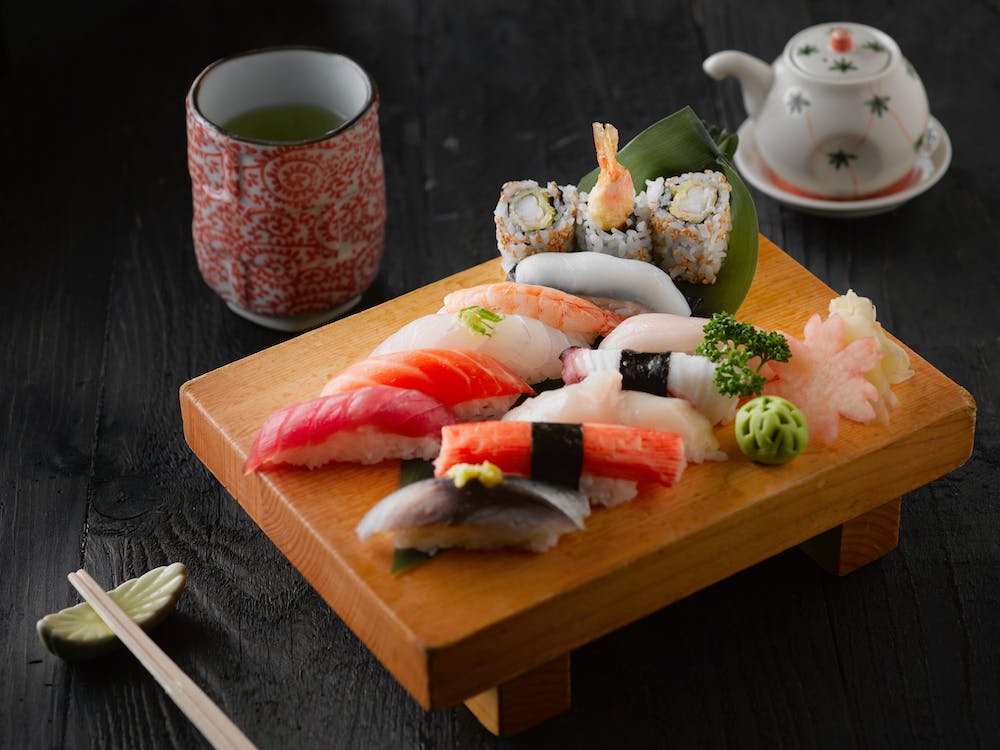
Sushi is a traditional Japanese dish that has gained immense popularity worldwide. It is a dish that consists of vinegared rice, often combined with seafood, vegetables, and other ingredients. The flavor profile of sushi is unique and complex, making it a delicacy enjoyed by many. In this section, we will explore the different taste elements that make up the flavor of sushi.
The Taste of Sushi
The taste of sushi is a combination of different flavors that work together to create a unique taste. The most prominent flavors are salty, sweet, sour, and umami. The salty taste comes from the soy sauce that is often served with sushi. The sweet taste comes from the rice and the toppings used. The sour taste comes from the vinegar used to season the rice. Umami is a savory taste that comes from the seafood and other ingredients used in sushi.
The Sweetness and Saltiness
Sushi has a delicate balance of sweetness and saltiness. The sweetness comes from the rice, which is seasoned with sugar and vinegar. The saltiness comes from the soy sauce and the toppings used. The sweetness and saltiness work together to create a harmonious taste that is both savory and satisfying.
The Spiciness
Sushi can also have a spicy kick to it. The spiciness comes from the wasabi that is often served with sushi. Wasabi is a Japanese horseradish that has a pungent flavor and is used to add heat to sushi. It is important to note that wasabi should be used sparingly as it can be quite potent.
The Freshness
Freshness is an essential element of sushi. The seafood used in sushi should be fresh and of high quality. The freshness of the seafood is what gives sushi its unique flavor and texture. It is important to note that sushi should be consumed as soon as possible after it is prepared to ensure that it is fresh and delicious.
In conclusion, sushi has a unique flavor profile that is a combination of different tastes and elements. The delicate balance of sweetness, saltiness, sourness, and umami creates a harmonious taste that is both satisfying and delicious. The spiciness and freshness of the ingredients used also add to the complexity of the flavor.
The Ingredients of Sushi
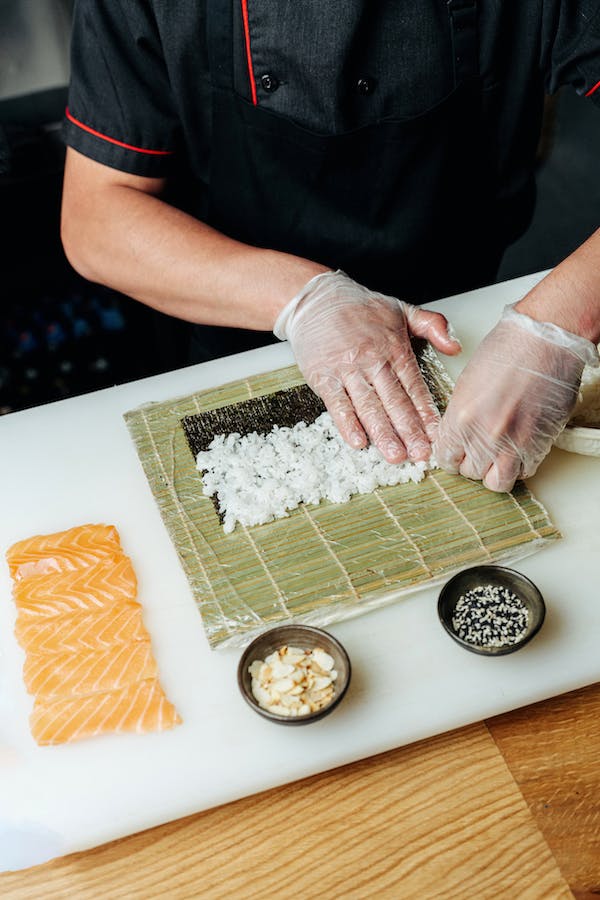
Sushi is a traditional Japanese dish that consists of vinegared rice and other ingredients, such as seafood, vegetables, and condiments. Understanding the role of each ingredient in sushi is crucial to appreciating the unique taste of this dish.
The Role of Rice
Rice is the foundation of sushi. Sushi rice is a short-grain rice that is cooked with vinegar, sugar, and salt. The vinegar gives the rice a slightly sour taste, which balances the other flavors in the dish. The rice is also sticky, which makes it easy to form into bite-sized pieces.
The Role of Fish
Fish is the most common ingredient in sushi. Raw fish is often used, but cooked fish can also be used. The type of fish used in sushi varies depending on the region and season. Some popular fish used in sushi include tuna, salmon, and yellowtail.
The Role of Vegetables and Fruits
Vegetables and fruits are often used as toppings in sushi. Cucumber, avocado, and carrots are commonly used vegetables, while tropical fruit such as peach can also be used. These ingredients add texture and flavor to the dish.
The Role of Condiments
Condiments are an essential part of sushi. Wasabi, soy sauce, and pickled ginger are commonly served with sushi. Wasabi is a spicy paste made from horseradish that is used to add heat to the dish. Soy sauce is used to add saltiness, while pickled ginger is used to cleanse the palate between bites.
In conclusion, the ingredients of sushi play a crucial role in creating its unique taste. From the vinegared rice to the fresh seafood, each ingredient is carefully selected to create a balanced and flavorful dish.
Types of Sushi and Their Taste

Sushi is a Japanese dish that has gained worldwide popularity due to its unique taste and presentation. There are several types of sushi, each with its own distinct taste. In this section, we will discuss the taste of different types of sushi.
Taste of Maki
Maki sushi is a type of sushi that is made by rolling sushi rice and various ingredients in a sheet of nori seaweed. Maki sushi is commonly served in bite-sized pieces. The taste of maki sushi varies depending on the ingredients used. Some common ingredients used in maki sushi include cucumber, avocado, crab meat, and raw fish. Maki sushi has a refreshing and light taste that is perfect for sushi beginners.
Taste of Nigiri
Nigiri sushi is a type of sushi that consists of a small ball of sushi rice topped with a slice of raw fish or other seafood. Nigiri sushi is hand-pressed, which gives it a unique texture. The taste of nigiri sushi varies depending on the type of fish used. Some common types of fish used in nigiri sushi include tuna, salmon, and eel. Nigiri sushi has a rich and savory taste that is perfect for sushi lovers.
Taste of Temaki
Temaki sushi is a type of sushi that is made by rolling sushi rice and various ingredients in a sheet of nori seaweed to form a cone shape. Temaki sushi is commonly served as a hand-held snack. The taste of temaki sushi varies depending on the ingredients used. Some common ingredients used in temaki sushi include shrimp, crab meat, and avocado. Temaki sushi has a crunchy and refreshing taste that is perfect for sushi lovers.
Taste of Chirashi
Chirashi sushi is a type of sushi that consists of a bowl of sushi rice topped with various ingredients such as raw fish, vegetables, and egg. Chirashi sushi has a colorful and vibrant appearance. The taste of chirashi sushi varies depending on the ingredients used. Some common ingredients used in chirashi sushi include tuna, salmon, and shrimp. Chirashi sushi has a refreshing and light taste that is perfect for sushi beginners.
Taste of Inari
Inari sushi is a type of sushi that consists of a pouch of fried tofu filled with sushi rice. Inari sushi is commonly served as a snack or appetizer. The taste of inari sushi varies depending on the ingredients used. Some common ingredients used in inari sushi include carrots, mushrooms, and sesame seeds. Inari sushi has a sweet and savory taste that is perfect for sushi lovers.
In conclusion, there are several types of sushi, each with its own unique taste. Whether you are a sushi beginner or a sushi lover, there is a type of sushi that will suit your taste buds.
Unique Sushi Tastes
Sushi is a dish that has a unique taste that can be difficult to describe. It is a combination of different flavors, textures, and aromas that come together to create a harmonious taste. The taste of sushi can vary depending on the type of sushi and the ingredients used. In this section, we will explore the unique tastes of seafood, vegetable, and fruit sushi.
Taste of Seafood Sushi
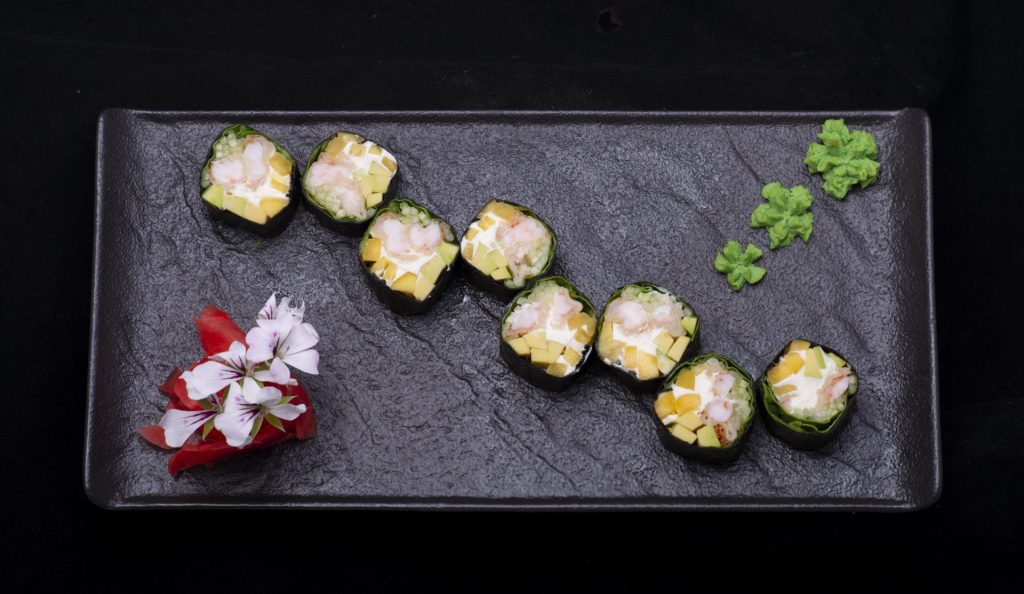
Seafood sushi is the most popular type of sushi. It is made with a variety of seafood such as tuna, salmon, eel, shrimp, and squid. The taste of seafood sushi can be described as fresh and mildly fishy. The texture of the fish can vary depending on the type of fish used. For example, tuna has a firm texture, while salmon has a softer texture.
One of the most popular types of seafood sushi is sashimi. Sashimi is made with fresh raw fish that is sliced thinly and served with soy sauce and wasabi. The taste of sashimi is delicate and fresh. It is important to note that sashimi does not include rice, which is a common ingredient in other types of sushi.
Taste of Vegetable Sushi
Vegetable sushi is a great option for vegetarians and vegans. It is made with a variety of vegetables such as mushrooms, cucumber, avocado, and tofu skin pouch. The taste of vegetable sushi can be described as tangy, sweet, and savory. The texture of the vegetables can vary depending on the type of vegetable used. For example, cucumber has a crunchy texture, while avocado has a creamy texture.
One of the most popular types of vegetable sushi is the California roll. The California roll is made with avocado, cucumber, and crab meat. It is then rolled in sushi rice and seaweed. The taste of the California roll is sweet and savory.
Taste of Fruit Sushi
Fruit sushi is a relatively new type of sushi that has gained popularity in recent years. It is made with a variety of fruits such as mango, peach, and strawberry. The taste of fruit sushi can be described as sweet and sour. The texture of the fruit can vary depending on the type of fruit used. For example, mango has a soft and juicy texture, while strawberry has a firm texture.
One of the most popular types of fruit sushi is the tekka maki. The tekka maki is made with fresh tuna and sushi rice. It is then rolled in seaweed and served with sweet soy sauce. The taste of the tekka maki is sweet and savory.
In conclusion, sushi is a dish that has a unique taste that can be difficult to describe. The taste of sushi can vary depending on the type of sushi and the ingredients used. Seafood sushi has a fresh and mildly fishy taste, vegetable sushi has a tangy, sweet, and savory taste, and fruit sushi has a sweet and sour taste.
Texture of Sushi

Sushi is not only about taste, but also about texture. The different textures of sushi ingredients work together to create a unique eating experience. In this section, we will explore the texture of sushi and its key components.
Texture of Rice
The texture of sushi rice is an important element of the overall sushi experience. The rice should be sticky enough to hold the shape of the sushi roll but not so sticky that it clumps together. The rice grains should be firm, yet tender, with a slightly chewy texture. The vinegar used to season the rice also adds a tangy flavor and a slightly acidic quality to the texture.
Texture of Fish
The texture of the fish used in sushi varies depending on the type of fish and how it is prepared. Some fish, such as tuna, have a firm and meaty texture, while others, like salmon, have a softer and more delicate texture. Sushi chefs often choose fish that is not too soft or too tough, but rather has a nice balance of firmness and tenderness. The fish should be fresh and have a clean taste, without any fishy or unpleasant odors.
Texture of Toppings
The toppings used in sushi can vary widely, from crunchy vegetables to creamy avocado. The texture of these toppings adds another layer of complexity to the sushi experience. For example, cucumber adds a refreshing crunch, while avocado provides a creamy and smooth texture. Other toppings, such as tempura flakes or sesame seeds, can add a crispy or crunchy texture to the sushi roll.
In conclusion, the texture of sushi is an important aspect of the overall sushi experience. The rice should be sticky and slightly chewy, the fish should be fresh and have a balanced texture, and the toppings should add a variety of textures to the roll. By paying attention to the texture of each ingredient, sushi chefs can create a harmonious and delicious sushi roll.
How to Eat Sushi
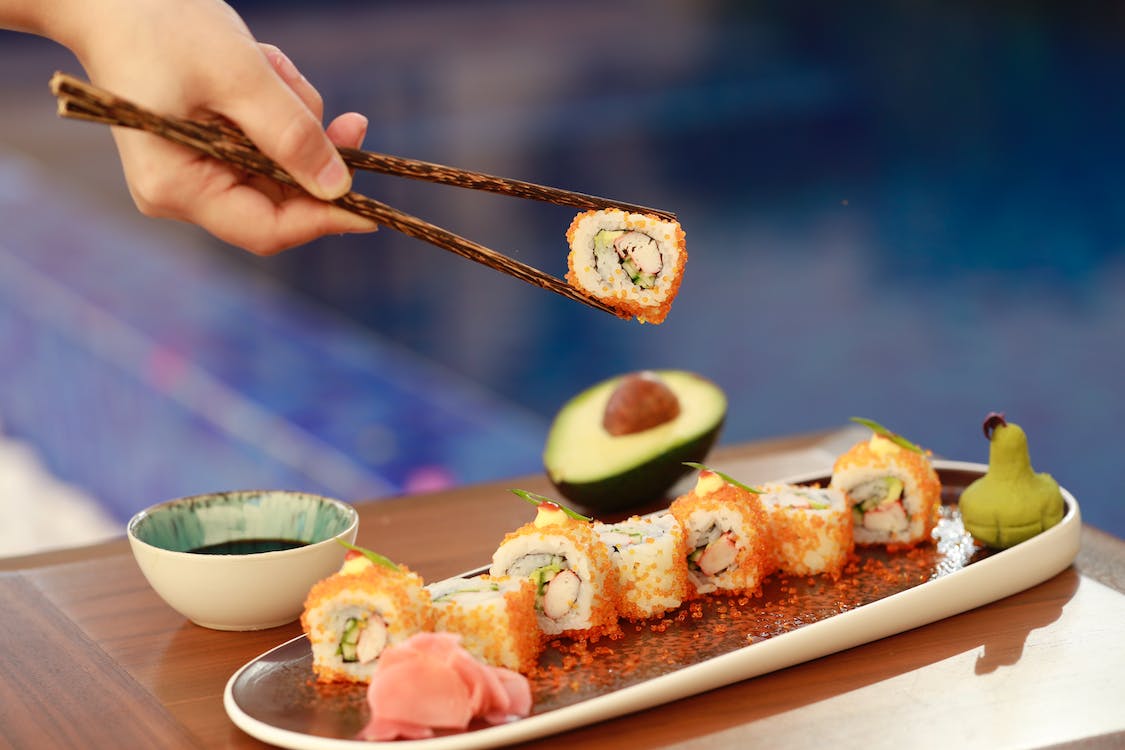
Sushi is a delicious and delicate dish that is enjoyed all over the world. However, if you are new to sushi, you may be unsure of how to eat it properly. In this section, we will cover the basics of how to eat sushi, including using chopsticks and eating with your hands.
Using Chopsticks
Using chopsticks is the traditional way to eat sushi in Japan. If you are comfortable using chopsticks, it is recommended to use them when eating sushi. Here are some tips on how to use chopsticks when eating sushi:
- Hold the chopsticks towards the end, leaving a little bit of space between them.
- Use your thumb, index finger, and middle finger to hold the chopsticks.
- Use the chopsticks to pick up the sushi by the rice, not the fish.
- Dip the sushi in soy sauce, but be careful not to soak the rice.
- Place the sushi in your mouth fish-side down, so that the fish touches your tongue.
Eating with Hands
If you are not comfortable using chopsticks, you can also eat sushi with your hands. Here are some tips on how to eat sushi with your hands:
- Hold the sushi with your fingers, using your thumb and middle finger to hold the sides of the sushi.
- Dip the sushi in soy sauce, but be careful not to soak the rice.
- Place the sushi in your mouth fish-side down, so that the fish touches your tongue.
It is important to note that when eating sushi with your hands, you should not touch the fish with your fingers. Instead, hold the sushi by the sides of the rice.
In conclusion, whether you choose to use chopsticks or your hands, the most important thing when eating sushi is to enjoy it!
Role of Sushi Chef

A sushi chef is a highly skilled professional who specializes in the art of sushi making. They are responsible for preparing, cooking, and presenting sushi dishes to customers in Japanese restaurants. Sushi chefs must have extensive knowledge of the different types of fish, seafood, and vegetables used in sushi making. They must also be able to prepare sushi rice correctly and have excellent knife skills to cut fish into precise slices.
The role of a sushi chef is crucial in maintaining the quality and authenticity of sushi dishes. They must ensure that the sushi they prepare meets the established guidelines on quality, portion size, and presentation. Sushi chefs must also inspect the quality of fruit, vegetables, and fish used to prepare the sushi dishes. They must ensure that the ingredients are fresh, of high quality, and safe for consumption.
To prepare sushi, a sushi chef uses a bamboo mat to roll the sushi rice and ingredients into a tight roll. The sushi chef then slices the roll into bite-sized pieces and presents them on a plate. The presentation of sushi is an essential aspect of sushi making, and sushi chefs must have a good eye for detail and aesthetics.
In addition to preparing sushi, sushi chefs must also maintain the cleanliness and hygiene of their work area. They must follow strict food safety regulations and ensure that the kitchen equipment is clean and well-maintained.
Overall, the role of a sushi chef is critical in ensuring that customers receive high-quality and authentic sushi dishes. They must have extensive knowledge of sushi making, excellent knife skills, and a good eye for detail and aesthetics. Sushi chefs must also maintain a clean and safe work environment to ensure the safety of their customers.
Health Benefits of Sushi
Sushi is not only a delicious and popular dish but also has several health benefits. Here are some of the reasons why sushi can be a healthy addition to your diet:
Rich in Protein
Sushi is a great source of protein, which is essential for building and repairing tissues in the body. The main ingredient in sushi is usually raw fish, which is a high-quality protein source. For example, a single piece of salmon sushi contains about 2 grams of protein. Additionally, sushi rolls that contain other protein sources like tofu or egg can provide even more protein.
Low in Calories
Sushi is generally low in calories, making it a great option for people who are watching their weight. A single piece of sushi usually contains around 40 to 60 calories, depending on the type. This means that you can enjoy several pieces of sushi without worrying about consuming too many calories.
Rich in Omega-3 Fatty Acids
Many types of fish used in sushi, such as salmon and tuna, are rich in omega-3 fatty acids. These healthy fats are essential for brain function and can also help reduce inflammation in the body. Omega-3 fatty acids have also been linked to a lower risk of heart disease and stroke.



Konnichiwa! (Hello!) I'm Pat Tokuyama, a Japanese tofu cookbook author, who travels for music, food, and adventure. If you like Japanese tea, checkout some of the newestorganic japanese tea, matcha bowls and noren and more!
** Curious about the Plant Based Japanese Cooking Club? ** Learn more here!
Contains Healthy Nutrients
In addition to protein and healthy fats, sushi also contains other important nutrients. For example, sushi rolls that contain vegetables like avocado, cucumber, or carrot provide fiber, vitamins, and minerals. Seaweed, which is often used to wrap sushi rolls, is also a good source of iodine, which is important for thyroid function.
Overall, sushi can be a healthy and delicious addition to your diet. However, it is important to choose sushi that is made with fresh, high-quality ingredients and to avoid rolls that are high in calories or sodium.


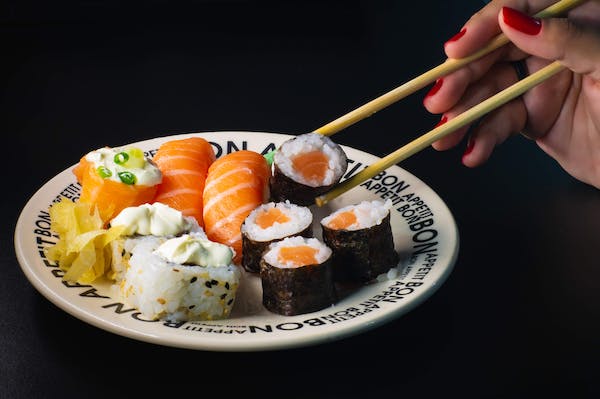



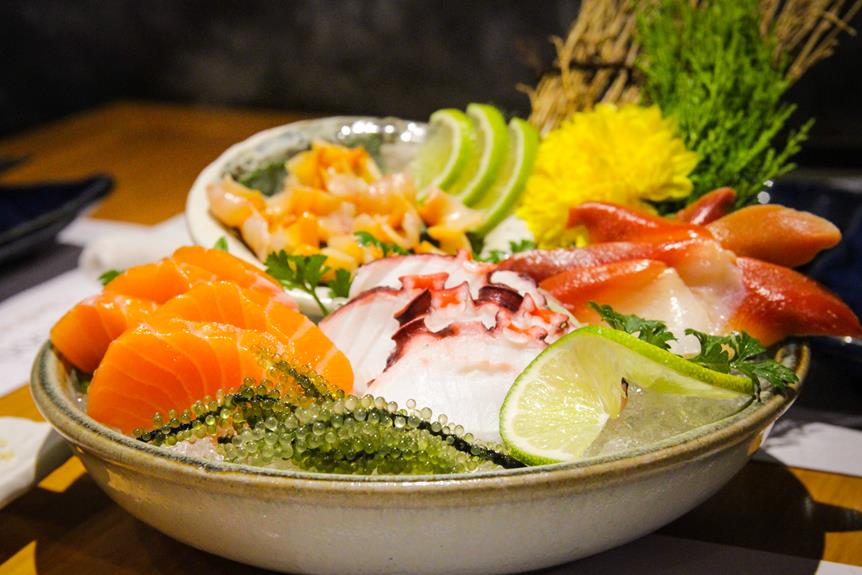

Konnichiwa! (Hello!) I'm Pat Tokuyama, a Japanese tofu cookbook author, who travels for music, food, and adventure. If you like Japanese tea, checkout some of the newestorganic japanese tea, matcha bowls and noren and more!
** Curious about the Plant Based Japanese Cooking Club? ** Learn more here!